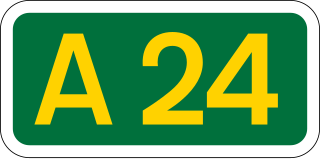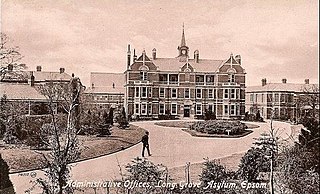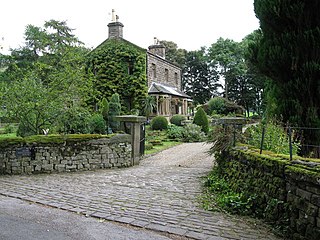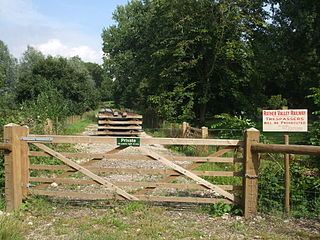
Epsom is a town in the Borough of Epsom and Ewell in Surrey, England, about 14 miles south of central London. The town is first recorded as Ebesham in the 10th century and its name probably derives from that of a Saxon landowner. The earliest evidence of human activity is from the mid-Bronze Age, but the modern settlement probably grew up in the area surrounding St Martin's Church in the 6th or 7th centuries and the street pattern is thought to have become established in the Middle Ages. Today the High Street is dominated by the clock tower, which was erected in 1847–8.

The A24 is a major road in England that runs for 53.2 miles (85.6 km) from Clapham in south-west London to Worthing on the English Channel in West Sussex via the suburbs of south-west London, as well as through the counties of Surrey and West Sussex.

The Dartmouth Steam Railway, formerly known as the Paignton and Dartmouth Steam Railway, is a 6.7-mile (10.8 km) heritage railway on the former Great Western Railway branch line between Paignton and Kingswear in Devon, England. Much of the railway's business is from summer tourists from the resorts of Torbay, who travel to Kingswear, where the Dartmouth Passenger Ferry takes them across the River Dart to Dartmouth.

The Hogsmill River in Surrey and Greater London, England is a small chalk stream tributary of the River Thames. It rises in Ewell and flows into the Thames at Kingston upon Thames on the lowest non-tidal reach, that above Teddington Lock.

The Axholme Joint Railway was a committee created as a joint enterprise between the Lancashire and Yorkshire Railway (L&Y) and the North Eastern Railway (NER) and was established by the North Eastern Railway Act of 31 July 1902. It took over the Goole and Marshland Railway, running from Marshland Junction near Goole to Reedness Junction and Fockerby, and the Isle of Axholme Light Railway, running from Reedness Junction to Haxey Junction. Construction of the Goole and Marshland Railway had begun in 1898, and by the time of the takeover in early 1903, was virtually complete. The Isle of Axholme Light Railway was started in 1899, but only the section from Reedness Junction to Crowle was complete at the takeover. The northern section opened on 10 August 1903, and the line from Crowle to Haxey Junction opened for passengers on 2 January 1905.

The East Coastway line is a railway line along the south coast of Sussex to the east of Brighton, England. Trains to the west of Brighton operate on the West Coastway line. Together with the West Coastway and the Marshlink line to the east, the line forms part of a continuous route from Havant to Ashford. The Brighton Main Line route to Eastbourne and Hastings, via Plumpton and Cooksbridge, shares the East Coastway line east of Lewes station.

Long Grove Hospital, formerly Long Grove Asylum, was a mental hospital, part of the Epsom Cluster of hospitals in the Horton area of Epsom, Surrey in the United Kingdom.

The Epsom Downs Branch is a 3-mile-65-chain (6.1 km) railway line in Greater London and Surrey, England. It runs from Sutton to its southern terminus at Epsom Downs, with intermediate stations at Belmont and Banstead. With the exception of the northernmost 39 ch (780 m), the branch is single track. All stations are managed by Southern, which operates all passenger trains. Most services run between Epsom Downs and London Victoria via Selhurst.

Birkenhead Dock Branch is a disused railway line running from the South junction of Rock Ferry, to the site of the former Bidston Dock on the Wirral Peninsula, England. The branch is approximately 4+1⁄2 miles (7.2 km) in length. Although called a branch, the line was accessible from both ends, from Bidston East junction and from Rock Ferry railway station. The former Mollington Street Rail Depot was branched into the line. A section of the line runs through Haymarket Tunnel and a low-level cutting through the centre of Birkenhead; visible from the road flyovers. The former Canning Street North signal box has now been demolished following fire damage, and the rails across the level crossing there have been removed due to the provision of cycle lanes on the roadway. The non-standard gates remain on the east side, but a fence has been erected on the other side despite the railway being officially out of use, rather than closed. Level crossings are also located at Duke Street and Wallasey Bridge Road. The railway lines are still partially intact.
Horton is a village in the borough of Epsom and Ewell, in the county of Surrey, England. It is situated between the towns and villages of Epsom, West Ewell, Chessington and Malden Rushett. Its principal road is Horton Lane, which runs the length of the area between West Ewell and Epsom Common. Horton Country Park also runs along the length of the area, between Epsom Common and West Ewell.

Horton Country Park is a 152.3-hectare (376-acre) Local Nature Reserve north-west of Epsom in Surrey. It is owned and managed by Epsom and Ewell Borough Council.
The Whittingham Hospital Railway (W.H.R.) was a private light railway operated by Lancashire County Council to serve Whittingham lunatic asylum. Opened in 1889, it carried goods and passengers between Grimsargh on the Preston and Longridge Railway and the hospital grounds. It closed to all traffic in 1957.

The Hellingly Hospital Railway was a light railway owned and operated by East Sussex County Council, used for transporting coal and passengers to Hellingly Hospital, a psychiatric hospital near Hailsham, from the London, Brighton and South Coast Railway's Cuckoo Line at Hellingly railway station.

West Park Hospital was a large psychiatric hospital in Epsom, Surrey.

The Epsom Cluster, also referred to as the Horton Estate, was a cluster or group of five large psychiatric hospitals situated on land to the west of Epsom.

Nidd Valley Light Railway was a light railway in upper Nidderdale in the West Riding of Yorkshire, England. It was owned by Bradford Corporation Waterworks Department and the corporation also operated its public passenger services. Power & Traction Ltd of London obtained a Light Railway Order for the 6.5-mile (10.5 km) railway from Pateley Bridge to Lofthouse in 1900, but these powers were taken over by Bradford Corporation. A contract to build Angram Reservoir was awarded to John Best & Son in 1903, and he also won the contract to build the public railway and a 6.5-mile (10.5 km) private extension to the reservoir site. This was initially built to 3 ft gauge but was converted to standard gauge by 1907, when the public railway opened. Best had his own locomotives, and Bradford Corporation equipped the public railway with second hand locomotives and carriages from the Metropolitan Railway.

Junction Road Halt, also known as Junction Road (for Hawkhurst), was a halt station on the Kent and East Sussex Railway. It was located on the eastern side of the level crossing across the B2244 Junction Road near the hamlet of Udiam in East Sussex, England. Closed for passengers in 1954 and freight in 1961 with the line, The line through Junction Road Halt may yet be revived as the Rother Valley Railway, a preservation society, is proposing to reopen the line from Robertsbridge to Bodiam.

Eynsham railway station served the Oxfordshire town of Eynsham and the Eynsham Sugar Beet Factory on the Oxford, Witney and Fairford Railway between Oxford and Witney.

The Thames Down Link is a 24 km (15 mi) official walking route linking the Thames Path and the North Downs Way. It starts in the town centre of Kingston upon Thames and finishes at Box Hill & Westhumble railway station.

The Manor Hospital, formerly The Manor Asylum and The Manor Certified Institution was a mental handicap and psychiatric hospital in Horton, near Epsom, Surrey, United Kingdom



















